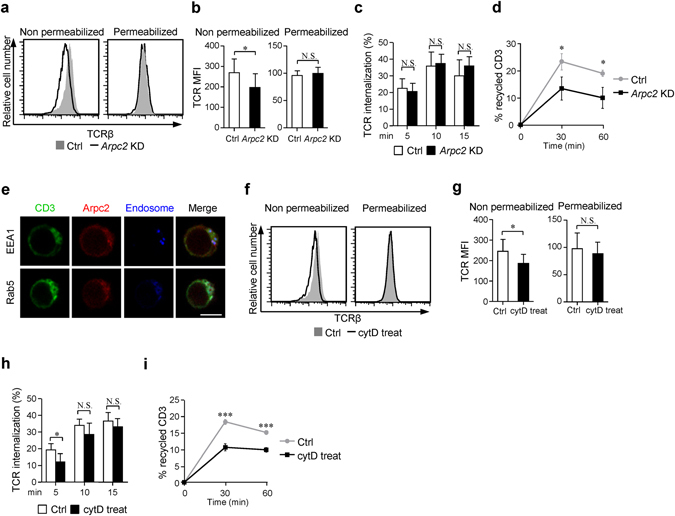Figure 5.

Arp2/3 complex promoted branched actin polymerization is required for surface TCR maintainance via regulating TCR+ endosome trafficking. (a) Flow cytometry analysis of surface and total TCRβ levels. (b) Histogram showing the MFI of surface (n = 13) and total TCRβ (n = 10) levels. (c) Control or Arpc2 KD Jurkat T cells were stained with anti-TCRβ-647 on ice after they were crosslinked at 37 °C for the indicated times. The cells were then stripped and analyzed for TCR internalization using FACS (n = 5). (d) Flow cytometry analysis of internalized TCR recycling in control or Arpc2 KD Jurkat T cells. The data are presented the percentage of internalized TCR receptors that had recycled back to the cell surface. (n = 3). (e) Immunofluorescence analysis of the location of CD3e (greeen), Arpc2 (red) and EEA1/Rab5 (blue) in Arpc2-mCherry Jurkat T cells. Bar is 5 μm. At least 30 cells were analyzed and representative images are shown. (f) Flow cytometry and (g) MFI analysis of TCR surface (n = 8) and total (n = 8) level in cytD treated Jurkat T cells compared with control cells. (h) Control or cytD treated Jurkat T cells were stained with anti-TCRβ-647 on ice, after crosslinking at 37 °C for the indicated times, cells were stripping and analyzed for TCR internalization by FACS. (n = 5). (i) Flow cytometry analysis of internalized TCR recycling in control or cytD treated Jurkat T cells. The data are presented as the percentage of internalized TCR receptors that have recycled back to the cell surface. (n = 3). The data are means ± S.D., for all panels: *P < 0.05; ***P < 0.001 by Student’s t-test, N.S.: no significance. All results are representative from at least three independent experiments.
